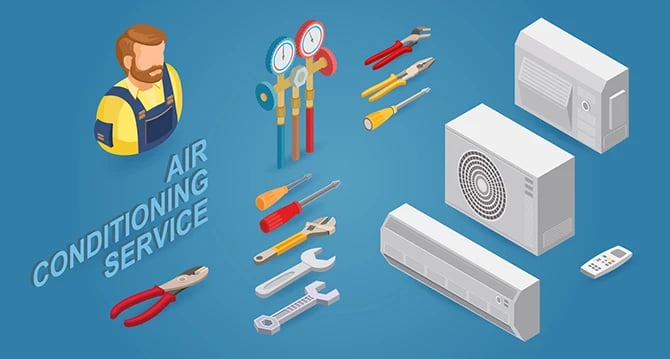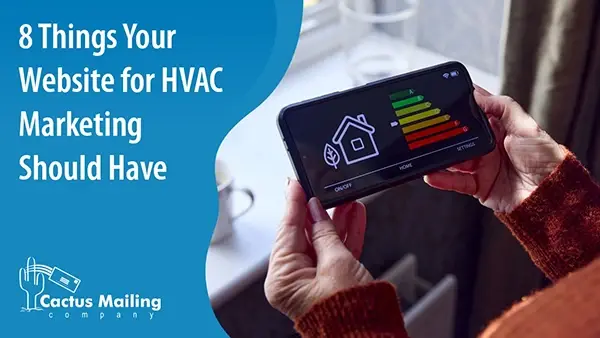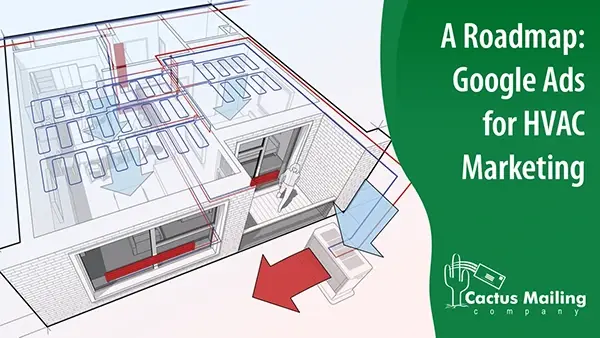We Are Here to Help!
What to Expect from Us:
No Pressure, Just Service!
Get no obligation pricing details and strategies that will work for your business.
A website intentionally designed for your HVAC (Heating, Ventilation, and Air Conditioning) services is a must for effective marketing. With more and more people turning to the internet to find HVAC services, your HVAC marketing needs a strong online presence to succeed.
Your HVAC website not only showcases your company's professionalism but also acts as a powerful marketing tool. A strategically optimized website allows potential customers to learn about your services, explore your offerings, and ultimately make informed decisions.
When visitors land on your website, they immediately form a first impression. Your HVAC website design can instill trust and confidence in your brand, making potential customers more likely to engage with your business. In this article, we will explore the key elements of creating an effective website for HVAC marketing.
1. A User-Friendly Site Navigation
An effective website utilizes clear and intuitive navigation to guide new customers through their decision journey. By organizing your website into logical sections, you can lead visitors to the information or conversion points they are seeking. Easy navigation enhances the user experience, making it more likely for potential clients to stay on your website and explore your offerings.
Clear and Intuitive Website Menu
The first impression matters. A website's navigation directly influences how users perceive the brand and interact with its content. A user-friendly design with clear navigation and well-organized content ensures that visitors can easily find the information they need contributing to a positive user experience. On the other hand, a cluttered or confusing menu can lead to frustration and a high bounce rate.
Here's how you can create a clear and intuitive menu:
- Simplify Categories: Avoid overwhelming visitors with too many menu options. Categorize content logically to streamline navigation.
- Use Descriptive Labels: Eliminate ambiguity by creating menu labels that accurately represent the content within each category.
- Prioritize Important Sections: Place key sections, such as services, prominently in the menu to facilitate easy access.

Website Mobile Responsiveness
Mobile responsiveness not only enhances user experience but also positively impacts search engine rankings. With the prevalence of mobile devices, ensuring that your HVAC website is optimized for various screen sizes is imperative.
- Fast Loading Times: Prioritize fast loading times by optimizing images, minimizing HTTP requests, and using asynchronous loading for non-essential elements. Mobile users often have limited patience for slow-loading websites.
- Flexible Images: Optimize images for mobile devices by using flexible images that can scale without losing quality. This maintains visual appeal on smaller screens and helps reduce load time.
- Mobile-Friendly Typography: Ensure that text is legible on smaller screens by using appropriate font sizes and maintaining proper line spacing. Avoid small fonts that may be challenging to read on mobile devices.
- Cross-Browser Compatibility: Guarantee that your mobile-responsive design works consistently across different mobile browsers, such as Chrome, Safari, and Firefox.
2. Visual Design that Holds Visitor Attention
A visually appealing website also helps create a positive first impression and entices website visitors to explore further. An effective website utilizes compelling visuals and engaging design elements to capture the attention and interest of potential customers. By incorporating high-quality images, graphics, and videos that showcase your HVAC company's services, projects, and satisfied customers, you can effectively communicate your brand's value and differentiate yourself from competitors in the HVAC industry.
Whether you're planning your website in-house or hiring an HVAC marketing agency, here are some ideas you can incorporate:
- Consistent Branding: Maintain a consistent visual identity throughout your HVAC digital marketing strategy. Your design, including logos, fonts, and imagery should always be the same to strengthen brand recognition and connection.
- Interactive Elements: In your HVAC web design, incorporate interactive features such as sliders, hover effects, or clickable elements to encourage user engagement and exploration.
- Contrast and Bold Elements: Introduce contrast and bold design elements to draw attention to specific areas, guiding users' focus and creating a visually dynamic composition.
- Animated Elements: Integrate subtle animations or motion graphics to add a dynamic and modern touch to your design, capturing users' interest without overwhelming them.
If you're looking for professional marketing services to help you with your website, check out the packages of HVAC Websites. You might find something that suits your requirements.
3. A Comprehensive Overview of Service Offerings
A well-designed website is a key component in attracting potential customers to your HVAC business. On your website, provide a comprehensive overview of HVAC services offered, highlighting specialties and expertise.
Clearly define the geographic areas your HVAC business serves to attract relevant local leads.

Highlight HVAC Services
Identify the range of HVAC services your business offers. Be specific by including the different offerings you provide such as:
- Heating Services: Installation and maintenance of heating systems, furnace repair and replacement, and heat pump services
- Ventilation Services: Ductwork installation and repair, ventilation system maintenance, and indoor air quality assessments
- Air Conditioning Services: AC unit installation and replacement, air conditioning repair, and routine AC maintenance
- Specialized Services: HVAC System Design, Energy-Efficiency Solutions, Ductless HVAC Systems, Humidity Control, Geothermal HVAC Systems, HVAC System Upgrades, and Smart Home Integration
- Emergency HVAC: HVAC Services or Backup Systems
- Commercial HVAC Services
Optimized Service Pages
Create dedicated pages for each service, optimizing them with relevant keywords. This not only helps in SEO but also provides detailed information for potential customers.
4. Content That Attracts and Retains Visitors
Your HVAC website also provides a platform for content marketing. By regularly updating your website with blog posts, articles, and helpful resources, you can establish yourself as an HVAC industry expert. Your website can become a go-to resource for potential customers looking for information or solutions to their HVAC needs. This not only attracts visitors but also encourages them to stay on your website longer, increasing the chances of conversion.
HVAC Blog
Maintain a blog section on your website with informative articles related to HVAC maintenance, energy efficiency, and industry trends. Engaging content not only educates visitors but also boosts SEO.
HVAC Video Content
Integrate video content showcasing HVAC installations, repair processes, and customer testimonials. Videos are engaging and can significantly increase user dwell time on your website.
5. Strategically Placed Call-to-Action (CTA)
Another effective way a website can attract new customers is by incorporating lead generation forms and contact information strategically. By including contact forms, newsletter sign-ups, and click-to-call buttons in strategic locations throughout your website, you make it convenient for potential customers to get in touch with your business or take the desired action. This simplifies the process for potential clients, increasing the likelihood of conversion.
Guiding Users Towards Conversion
Effective calls-to-action (CTAs) are essential for converting visitors into customers. Craft CTAs with persuasive and action-oriented words to prompt immediate responses. Make them easily visible and logically fit within the user journey. Placing prominent CTAs strategically guides users toward desired actions. Here are some examples of compelling CTAs for your HVAC service:
Call or Send a Message
- Emergency HVAC Repairs – Call Now
- Beat the heat – Call us for quick and reliable AC repairs
- Experience Hassle-Free HVAC Repairs – Contact Us Now
Sign up for email marketing
- Subscribe to HVAC Tips and Exclusive Offers
- Unlock Exclusive Offers – Subscribe to our newsletter
- Download our FREE guide to Energy-Efficient Heating and Cooling
- Join our HVAC Club for Exclusive Benefits

Get a free estimate
- Schedule a FREE inspection
- Get a Free Estimate for HVAC Installations
- HVAC Consultation - FREE Ideas for Your Home
- Unlock Energy Savings - Schedule a FREE Audit
- Cool savings, hot service – Get a free estimate on installations
Book a maintenance service
- Stay Cozy This Winter - Schedule Your Heating Check
- Ready for A Cool Summer? Schedule Your AC Tune-Up
- Stay Worry-Free – Join Our HVAC Maintenance Plan
- Book Now For An Exclusive Tune-Up Offer
- Breathe Easy with Clean Air – Book Your Duct Cleaning Service
- Claim a Limited-Time Offer
- Explore Available Special Financing Offers
6. Seamless Social Media Integration
Staying connected with your customers goes beyond the boundaries of your website. That's why you must seamlessly integrate your HVAC services with social media marketing for an enhanced online experience.
Quick Links to Social Media Platforms
Explore an extended online community by telling your visitors to follow you on social media. Keep them updated on the latest HVAC trends, tips, and exclusive offers by connecting with them on platforms like Facebook, X (formerly Twitter), Instagram, and TikTok.
Sharing Buttons for User Engagement
There is power in networks and spreading the word organically through social media marketing. By incorporating a user-friendly sharing button, your website visitors will be able to effortlessly share valuable pieces of information or exciting offers through various HVAC social media platforms.
Real-Time Updates with Social Media Feeds
Give real-time insights into your world. Seamlessly integrate your social media feeds, providing instant updates, industry news, and behind-the-scenes glimpses. Let your website visitors have a closer look at your commitment to excellence and customer satisfaction.
Have a look at the HVAC digital marketing services offered by Thrive Agency.
7. A Section That Builds and Strengthens Your Credibility
Have a dedicated section to showcase your portfolio and highlight customer testimonials. This acts as a powerful marketing tool, reassuring potential customers of your expertise and the quality of HVAC service. You can effectively differentiate yourself from competitors and build trust with your audience by incorporating compelling visuals and testimonials from satisfied clients.

Customer Testimonials
Feature customer testimonials prominently on your website. Positive reviews build trust and credibility, influencing potential customers to choose your HVAC services.
Certifications and Awards
Display industry certifications and any awards your HVAC business has received. This adds a layer of credibility and reassures visitors of your expertise.
8. An Extensive FAQ Section
A frequently asked questions (FAQ) section is a valuable component of a website that not only serves the immediate needs of users but also contributes to a more positive overall online experience, improving customer satisfaction and engagement.
With an FAQ section, users can save time by helping visitors find information easily, reducing the need to contact customer support or browse through various pages. In turn, this reduces the workload on support teams and lowers bounce rates, contributing to a better overall user experience.
Here are a few questions you can start with:
- How often should I schedule HVAC maintenance for my system?
- What are the signs that my heating, ventilation, or air conditioning system needs repair?
- What are the benefits of regular HVAC maintenance?
- What is the lifespan of an HVAC system?
- What size HVAC system do I need for my home?
- How can I improve indoor air quality in my home?
- Are there any DIY tasks I can perform to maintain my HVAC system?
- What factors determine the size of an HVAC system for our workplace?
- Are smart thermostats worth the investment?
- What types of HVAC systems are suitable for different climates?
- How can I make my HVAC system more energy-efficient?
- What are the benefits of upgrading to a high-efficiency HVAC system?
- What is the importance of indoor humidity control?
- Do you offer emergency HVAC services? How can I access them?
- Can you provide an estimate for HVAC installation or repair services?
Tools to Optimize Your HVAC Website
To ensure your website stands out and performs at its best, leverage powerful tools to enhance your visibility and provide valuable insights into user behavior and site performance.
These tools are designed to optimize your HVAC website, helping you reach a broader audience and deliver an exceptional online experience.
Search Engine Optimization (SEO)
Your website can rank higher in Google search results, making it easier for a potential customer to find you when you incorporate search engine optimization (SEO) best practices. More organic traffic and increased opportunities for conversions will be the direct result of a proper HVAC web design.
By optimizing your website's content, meta tags, and URLs with relevant keywords and phrases, you increase the chances of being discovered by those actively searching for HVAC services.
Interested in HVAC SEO? Check out the service offering of HVAC WebMasters.
Google My Business Integration
Optimize your Google My Business listing or Google Business profile with accurate business information, opening hours, and customer reviews. Interested customers that click on a Google Ad can either be directed to your Google Business profile or HVAC contractor marketing website.
Local Keywords Implementation
Incorporate local keywords naturally into your website content. Implementing local SEO strategies can further enhance a local business website's visibility in a target geographic area by appearing in local search results. You can also implement Google local service ads to help you rank higher in Google search.

Performance Tracking: Google Analytics
Stay ahead with your HVAC digital marketing strategy that harnesses the power of data to optimize user experience. Track the performance of your HVAC website using Google Ads' Analytics. You'll have access to data such as website traffic, user engagement, conversion tracking, audience segmentation, traffic sources, and more. You can then analyze user behavior and website metrics to help you make data-driven improvements to your website or online marketing efforts.
Conclusion
A website plays a crucial role in attracting potential customers to your HVAC business. By providing valuable content, utilizing compelling visuals, incorporating clear navigation, and optimizing for search engines, you can effectively capture the attention and interest of potential customers. A well-designed and user-friendly website acts as a powerful marketing tool, establishing your online presence, helping your HVAC business stand out from the competition and drive conversions.
Our postcards have helped various businesses get leads, boost awareness, and grow revenue. Let us help you create an HVAC marketing postcard design that can achieve your marketing goals!

 Cactus Mail Team: Apr 01, 2024
Cactus Mail Team: Apr 01, 2024



 Jill Brown
Jill Brown